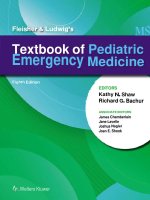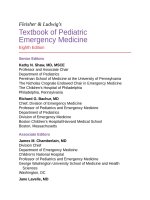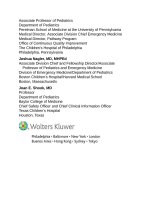Pediatric emergency medicine trisk 0310 0310
Bạn đang xem bản rút gọn của tài liệu. Xem và tải ngay bản đầy đủ của tài liệu tại đây (76.55 KB, 1 trang )
transport, as this could seriously affect their ability to function optimally. Further,
weight restrictions for personnel may need to be considered for air transport.
Transport teams should consider the development and use of a pretransport
“Safety Checklist.” This tool should be meticulously completed for each
transport. It should include a comprehensive review of necessary equipment,
medications, oxygen supply, essential demographic information, and other
important reminders. All team members should participate in the completion of
the safety checklist, and it should be done for all modes of transport. A similar
checklist should also be completed prior to departing from the referring
institution. Figure 11.3 depicts a sample safety checklist from The Children’s
Hospital of Philadelphia.
During the transport process, one must be prepared for all types of patients and
complications. Patient status can vary from stable to critically ill. The disease
processes involved are detailed throughout this text and include patients with
unclear diagnoses, progressively worsening illnesses, traumatic injuries, and
medical or surgical disease needing further management or subspecialty care.
Transport clinicians should be prepared to handle the entire spectrum of ages
from very low–birth weight, premature neonates through adolescence. Although
the primary survey (airway, breathing, circulation) approach to care is always
vital during interfacility transport, it is essential to understand the disease process
and expected progression of the disease during the anticipated transport period.
Interestingly, prior studies have demonstrated that patients requiring interfacility
transfer often have higher illness severity scores and resource utilization than
similar patients who are admitted within the same institution, indicating a
potentially sicker patient population.
When the transport team arrives at the referring facility, the patient’s status
may be significantly different than initially described. This can be the result of
progression of disease, unexpected change in the patient’s condition, incomplete
assessment by the referring provider, or suboptimal communication between the
referring and accepting clinicians. Thus, the ability to correctly assess the severity
of illness or injury, and then transmit that information to the accepting team, is
crucial to facilitate appropriate triage and advice for pretransport care. This
process also enables sound decision making regarding the best mode of transport
(air or ground) and proper personnel configuration. Use of electronic adjuncts to
care is also increasing; telemedicine interactions prior to and during transport can
potentially augment information flow and accessibility, ultimately improving
patient care and safety. The transport team may also be asked to transfer a
different patient if a more critical patient has presented to the same referring









